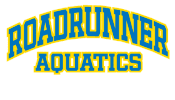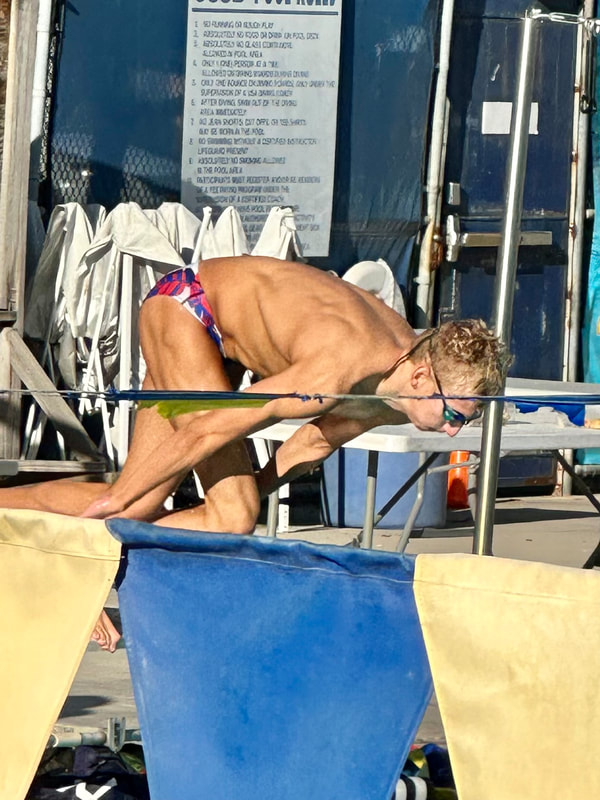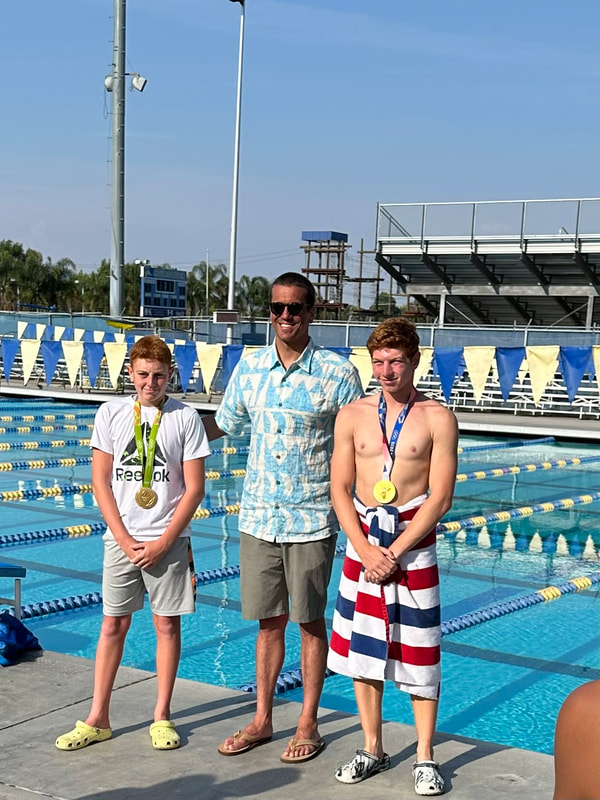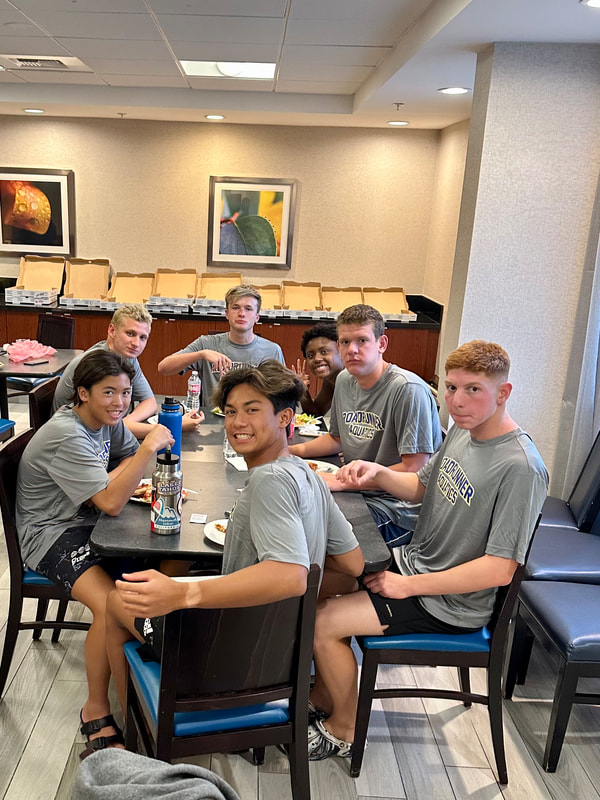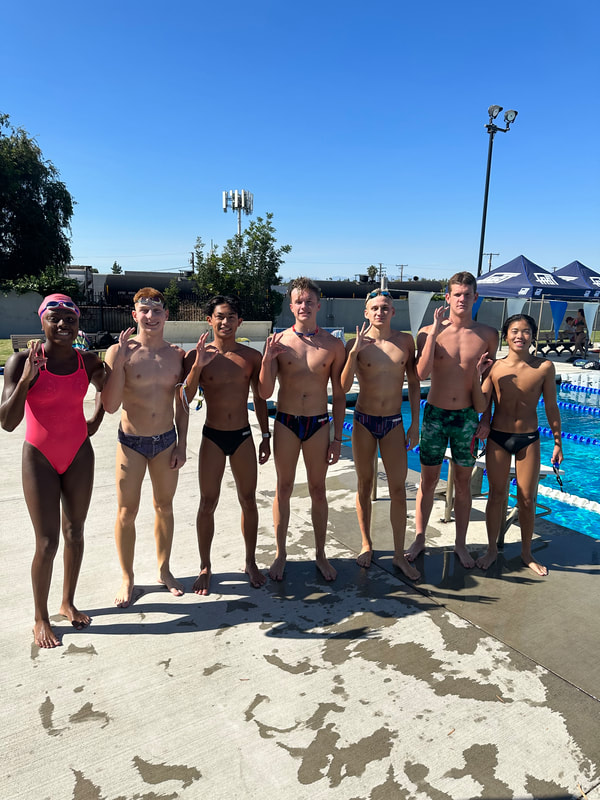Practice Behavior:
Athletes are encouraged to support their teammates at practices as well as during competition. Working together and creating a fun and safe environment is an important part of Roadrunner Aquatics.
Athletes are expected at all times to follow the verbal directions of the coaching staff. At no time will disrespectful attitudes be tolerated. Coaching staff has the right to remove any swimmer from practice who continue to display disruptive behavior.
Abusive language, lying, stealing, or vandalism will not be tolerated.
Athletes may leave practice only with the coach’s permission.
Athletes are expected to follow the rules and regulations of all facilities used.
Athletes are expected to follow the practice etiquette established by the group coach.
Athlete Code of Conduct:
As a Roadrunner Aquatics Athlete I promise to show respect and common courtesies at all times to my team members, coaches, competitors, officials, parents, and for all facilities and other property used during practice and/or competition.
I promise to demonstrate good sportsmanship during all practices, competitions and team activities.
I will be an active participant in all team practices, competitions, fundraising events and other team activities.
I will come to all team sponsored events in the appropriate attire.
I will respect the coaches’ and officials’ instructions and will make every effort to be on time for workouts, competitions, and team events.
I will refrain from using alcohol, tobacco, drugs, other prohibited substances, violence, defamatory, or foul language, inappropriate sexual conduct or any other behavior deemed, dishonest, discourteous, offensive or disrespectful of others.
Anti-Bullying Policy:
Bullying of any kind is unacceptable at Roadrunner Aquatics and will not be tolerated. Roadrunner Aquatics is committed to providing a safe, caring and friendly environment for all of our members. If bullying does occur, all athletes and parents should know that incidents will be dealt with promptly and effectively. Anyone who knows that bullying is happening is expected to tell a coach immediately.
WHAT IS BULLYING?
The USA Swimming Code of Conduct prohibits bullying. Generally, bullying is the use of aggression, whether intentional or not, which hurts another person. Bullying results in pain and distress. The USA Swimming Code of Conduct defines bullying in 304.3.7. Bullying is the severe or repeated use by one or more USA Swimming members of oral, written, electronic or other technological expression, image, sound, data or intelligence of any nature (regardless of the method of transmission), or a physical act or gesture , or any combination thereof, directed at any other member that to a reasonably objective person has the effect of:
Reporting Procedure:
An athlete who feels that he or she has been bullied is asked to do one or more of the following things:
• Talk to your parents;
• Talk to a Team Coach
• Write a letter or email to the Team Coach
• Make a report to the USA Swimming Safe Sport staff.
Every effort should be made to bring the complaint to the attention of the appropriate leadership as soon as possible to make sure that memories are fresh and behavior can be accurately recalled and the bullying behavior can be stopped as soon as possible.
HOW WE HANDLE BULLYING
If bullying is occurring during team-related activities, we stop bullying on the spot using the following steps:
1. Intervene immediately. It is ok to get another adult to help.
2. Separate the kids involved.
3. Make sure everyone is safe.
4. Meet any immediate medical or mental health needs.
5. Stay calm. Reassure the kids involved, including bystanders.
6. Model respectful behavior when you intervene.
FINDING OUT WHAT HAPPENED
1. First, we get the facts.
a. Keep all the involved children separate.
b. Get the story from several sources, both adults and kids.
c. Listen without blaming.
d. Don’t call the act “bullying” while you are trying to understand what happened.
e. It may be difficult to get the whole story, especially if multiple athletes are involved or the bullying involves social bullying or cyber bullying. Collect all available information.
2. Then, we determine if it's bullying. There are many behaviors that look like bullying but require different approaches. It is important to determine whether the situation is bullying or something else.
a. Review the USA Swimming definition of bullying;
b. To determine if the behavior is bullying or something else, consider the following questions:i)What is the history between the kids involved?
ii)Have there been past conflicts?
iii)Is there a power imbalance? Remember that a power imbalance is not limited to physical strength. It is sometimes not easily recognized. If the targeted child feels like there is a power imbalance, there probably is.
iv)Has this happened before? Is the child worried it will happen again?
c. Remember that it may not matter “who started it.” Some kids who are bullied may be seen as annoying or provoking, but this does not excuse the bullying behavior.
d. Once you have determined if the situation is bullying, support all of the kids involved.
SUPPORTING THE KIDS INVOLVED
3. Support the kids who are being bullied
a. Listen and focus on the child. Learn what’s been going on and show you want to help. Assure the child that bullying is not their fault.
b. Work together to resolve the situation and protect the bullied child. The child, parents, and fellow team members and coaches may all have valuable input. It may help to:
i. Ask the child being bullied what can be done to make him or her feel safe. Remember that changes to routine should be minimized. He or she is not at fault and should not be singled out. For example, consider rearranging lane assignments for everyone. If bigger moves are necessary, such as switching practice groups, the child who is bullied should not be forced to change.
ii. Develop a game plan. Maintain open communication between the Team and parents. Discuss the steps that will be taken and how bullying will be addressed going forward.
c. Be persistent. Bullying may not end overnight. Commit to making it stop and consistently support the bullied child.
4. Address bullying behavior
a. Make sure the child knows what the problem behavior is. Young people who bully must learn their behavior is wrong and harms others.
b. Show kids that bullying is taken seriously. Calmly tell the child that bullying will not be tolerated. Model respectful behavior when addressing the problem.
c. Work with the child to understand some of the reasons he or she bullied. For example:
i. Sometimes children bully to fit in or just to make fun of someone is a little different from them. In other words, there may be some insecurity involved.
ii. Other times kids act out because something else—issues at home, abuse, stress—is going on in their lives. They also may have been bullied. These kids may be in need of additional support.
d. Involve the kid who bullied in making amends or repairing the situation. The goal is to help them see how their actions affect others. For example, the child can:
i. Write a letter apologizing to the athlete who was bullied.
ii. Do a good deed for the person who was bullied, for the Team, or for others in your community.
iii. Clean up, repair, or pay for any property they damaged.
e. Avoid strategies that don’t work or have negative consequences:
i. Zero tolerance or “three strikes, you’re out” strategies don’t work. Suspending or removing from the team swimmers who bully does not reduce bullying behavior. Swimmers may be less likely to report and address bullying if suspension or getting kicked off the team is the consequence.
ii. Conflict resolution and peer mediation don’t work for bullying. Bullying is not a conflict between people of equal power who share equal blame. Facing those who have bullied may further upset kids who have been bullied.
f. Follow-up. After the bullying issue is resolved, continue finding ways to help the child who bullied to understand how what they do affects other people. For example, praise acts of kindness or talk about what it means to be a good teammate.
5. Support bystanders who witness bullying. Every day, kids witness bullying. They want to help, but don’t know how. Fortunately, there are a few simple, safe ways that athletes can help stop bullying when they see it happening.
a. Be a friend to the person being bullied;
b. Tell a trusted adult – your parent, coach, or team board member;
c. Help the kid being bullied get away from the situation. Create a distraction, focus the attention on something else, or offer a way for the target to get out of the situation. “Let’s go, practice is about to start.”
d. Set a good example by not bullying others.
e. Don’t give the bully an audience. Bullies are encouraged by the attention they get from bystanders. If you do nothing else, just walk away.
ELECTRONIC COMMUNICATION
USA Swimming teams are now required to implement an electronic communication policy. The policy must be reviewed with and agreed to by all athletes, parents, coaches and other adults affiliated with the team. The following is the policy for appropriate electronic communication between adults and athletes, and is provided to assist USA Swimming member teams with developing their own policies. Each member team and each LSC has the responsibility for approval and implementation of its own electronic communication policy.
Electronic Communication Policy
PURPOSE
Roadrunner Aquatics recognizes the prevalence of electronic communication and social media in today’s world. Many of our swimmers use these means as their primary method of communication. While the Team acknowledges the value of these methods of communication, the Team also realizes that there are associated risks that must be considered when adults use these methods to communicate with minors.
GENERAL CONTENT
All communications between a coach or other adult and an athlete must be professional in nature and for the purpose of communicating information about team activities. The content and intent of all electronic communications must adhere to the USA Swimming Code of Conduct regarding Athlete Protection.
For example, as with any communication with an athlete, electronic communication should not contain or relate to any of the following:
• drugs or alcohol use;
• sexually oriented conversation; sexually explicit language; sexual activity
• the adult’s personal life , social activities, relationship or family issues, or personal problems; and
• inappropriate or sexually explicit pictures
• Note: Any communication concerning an athlete's personal life, social activities, relationship or family issues or personal problems must be transparent, accessible and professional.
Whether one is an athlete, coach, or parent, the guiding principle to always use in communication is to ask: “Is this communication something that someone else would find appropriate or acceptable in a face-to-face meeting?” or “Is this something you would be comfortable saying out loud to the intended recipient of your communication in front of the intended recipient’s parents, the coaching staff, or other athletes?”
With respect to electronic communications, a simple test that can be used in most cases is whether the electronic communication with swimmers is Transparent, Accessible and Professional.
Transparent: All electronic communication between coaches and athletes should be transparent. Your communication should not only be clear and direct, but also free of hidden meanings, innuendo and expectations.
Accessible: All electronic communication between coaches and athletes should be considered a matter of record and part of the Team’s records. Whenever possible, include another coach or parent in the communication so that there is no question regarding accessibility.
Professional: All electronic communication between a coach and an athlete should be conducted professionally as a representative of the Team. This includes word choices, tone, grammar, and subject matter that model the standards and integrity of a staff member.
If your communication meets all three of the T.A.P. criteria, then it is likely your method of communication with athletes will be appropriate.
FACEBOOK, INSTAGRAM, BLOGS, AND SIMILAR SITES
Coaches may have personal Facebook (or other social media site) pages, but they are not permitted to have any athlete member of the Team join their personal page as a “friend.” A coach should not accept any “friend” request from an athlete. In addition, the coach should remind the athlete that this is not permitted. Coaches and athletes are not permitted to “private message” each other through Facebook. Coaches and athletes are not permitted to “instant message” each other through Facebook chat or other IM method.
The Team has an official Facebook page that athletes and their parents can “follow” for information and updates on team-related matters.
Coaches are encouraged to set their pages to “private” to prevent athletes from accessing the coach’s personal information.
TEXTING
Subject to the general guidelines mentioned above, texting is allowed between coaches and athletes during the hours from 7am-8pm. Texting only shall be used for the purpose of communicating information directly related to team activities.
EMAIL
Athletes and coaches may use email to communicate . When communicating with an athlete through email, a parent, or another coach should be CC'ed.
REQUEST TO DISCONTINUE ALL ELECTRONIC COMMUNICATIONS
The parents or guardians of an athlete may request that their child not be contacted by coaches through any form of electronic communication.
Athletes are encouraged to support their teammates at practices as well as during competition. Working together and creating a fun and safe environment is an important part of Roadrunner Aquatics.
Athletes are expected at all times to follow the verbal directions of the coaching staff. At no time will disrespectful attitudes be tolerated. Coaching staff has the right to remove any swimmer from practice who continue to display disruptive behavior.
Abusive language, lying, stealing, or vandalism will not be tolerated.
Athletes may leave practice only with the coach’s permission.
Athletes are expected to follow the rules and regulations of all facilities used.
Athletes are expected to follow the practice etiquette established by the group coach.
Athlete Code of Conduct:
As a Roadrunner Aquatics Athlete I promise to show respect and common courtesies at all times to my team members, coaches, competitors, officials, parents, and for all facilities and other property used during practice and/or competition.
I promise to demonstrate good sportsmanship during all practices, competitions and team activities.
I will be an active participant in all team practices, competitions, fundraising events and other team activities.
I will come to all team sponsored events in the appropriate attire.
I will respect the coaches’ and officials’ instructions and will make every effort to be on time for workouts, competitions, and team events.
I will refrain from using alcohol, tobacco, drugs, other prohibited substances, violence, defamatory, or foul language, inappropriate sexual conduct or any other behavior deemed, dishonest, discourteous, offensive or disrespectful of others.
Anti-Bullying Policy:
Bullying of any kind is unacceptable at Roadrunner Aquatics and will not be tolerated. Roadrunner Aquatics is committed to providing a safe, caring and friendly environment for all of our members. If bullying does occur, all athletes and parents should know that incidents will be dealt with promptly and effectively. Anyone who knows that bullying is happening is expected to tell a coach immediately.
WHAT IS BULLYING?
The USA Swimming Code of Conduct prohibits bullying. Generally, bullying is the use of aggression, whether intentional or not, which hurts another person. Bullying results in pain and distress. The USA Swimming Code of Conduct defines bullying in 304.3.7. Bullying is the severe or repeated use by one or more USA Swimming members of oral, written, electronic or other technological expression, image, sound, data or intelligence of any nature (regardless of the method of transmission), or a physical act or gesture , or any combination thereof, directed at any other member that to a reasonably objective person has the effect of:
- Causing physical or emotional harm to the other member or damage to the other member’s property;
- Placing the other member in reasonable fear of harm to himself/herself or of damage to his/her property;
- Creating a hostile environment for the other member at any USA Swimming activity;
- Infringing on the rights of the other member at any USA Swimming activity;
- Materially and substantially disrupting the training process or the orderly operation of any USA Swimming activity.
Reporting Procedure:
An athlete who feels that he or she has been bullied is asked to do one or more of the following things:
• Talk to your parents;
• Talk to a Team Coach
• Write a letter or email to the Team Coach
• Make a report to the USA Swimming Safe Sport staff.
Every effort should be made to bring the complaint to the attention of the appropriate leadership as soon as possible to make sure that memories are fresh and behavior can be accurately recalled and the bullying behavior can be stopped as soon as possible.
HOW WE HANDLE BULLYING
If bullying is occurring during team-related activities, we stop bullying on the spot using the following steps:
1. Intervene immediately. It is ok to get another adult to help.
2. Separate the kids involved.
3. Make sure everyone is safe.
4. Meet any immediate medical or mental health needs.
5. Stay calm. Reassure the kids involved, including bystanders.
6. Model respectful behavior when you intervene.
FINDING OUT WHAT HAPPENED
1. First, we get the facts.
a. Keep all the involved children separate.
b. Get the story from several sources, both adults and kids.
c. Listen without blaming.
d. Don’t call the act “bullying” while you are trying to understand what happened.
e. It may be difficult to get the whole story, especially if multiple athletes are involved or the bullying involves social bullying or cyber bullying. Collect all available information.
2. Then, we determine if it's bullying. There are many behaviors that look like bullying but require different approaches. It is important to determine whether the situation is bullying or something else.
a. Review the USA Swimming definition of bullying;
b. To determine if the behavior is bullying or something else, consider the following questions:i)What is the history between the kids involved?
ii)Have there been past conflicts?
iii)Is there a power imbalance? Remember that a power imbalance is not limited to physical strength. It is sometimes not easily recognized. If the targeted child feels like there is a power imbalance, there probably is.
iv)Has this happened before? Is the child worried it will happen again?
c. Remember that it may not matter “who started it.” Some kids who are bullied may be seen as annoying or provoking, but this does not excuse the bullying behavior.
d. Once you have determined if the situation is bullying, support all of the kids involved.
SUPPORTING THE KIDS INVOLVED
3. Support the kids who are being bullied
a. Listen and focus on the child. Learn what’s been going on and show you want to help. Assure the child that bullying is not their fault.
b. Work together to resolve the situation and protect the bullied child. The child, parents, and fellow team members and coaches may all have valuable input. It may help to:
i. Ask the child being bullied what can be done to make him or her feel safe. Remember that changes to routine should be minimized. He or she is not at fault and should not be singled out. For example, consider rearranging lane assignments for everyone. If bigger moves are necessary, such as switching practice groups, the child who is bullied should not be forced to change.
ii. Develop a game plan. Maintain open communication between the Team and parents. Discuss the steps that will be taken and how bullying will be addressed going forward.
c. Be persistent. Bullying may not end overnight. Commit to making it stop and consistently support the bullied child.
4. Address bullying behavior
a. Make sure the child knows what the problem behavior is. Young people who bully must learn their behavior is wrong and harms others.
b. Show kids that bullying is taken seriously. Calmly tell the child that bullying will not be tolerated. Model respectful behavior when addressing the problem.
c. Work with the child to understand some of the reasons he or she bullied. For example:
i. Sometimes children bully to fit in or just to make fun of someone is a little different from them. In other words, there may be some insecurity involved.
ii. Other times kids act out because something else—issues at home, abuse, stress—is going on in their lives. They also may have been bullied. These kids may be in need of additional support.
d. Involve the kid who bullied in making amends or repairing the situation. The goal is to help them see how their actions affect others. For example, the child can:
i. Write a letter apologizing to the athlete who was bullied.
ii. Do a good deed for the person who was bullied, for the Team, or for others in your community.
iii. Clean up, repair, or pay for any property they damaged.
e. Avoid strategies that don’t work or have negative consequences:
i. Zero tolerance or “three strikes, you’re out” strategies don’t work. Suspending or removing from the team swimmers who bully does not reduce bullying behavior. Swimmers may be less likely to report and address bullying if suspension or getting kicked off the team is the consequence.
ii. Conflict resolution and peer mediation don’t work for bullying. Bullying is not a conflict between people of equal power who share equal blame. Facing those who have bullied may further upset kids who have been bullied.
f. Follow-up. After the bullying issue is resolved, continue finding ways to help the child who bullied to understand how what they do affects other people. For example, praise acts of kindness or talk about what it means to be a good teammate.
5. Support bystanders who witness bullying. Every day, kids witness bullying. They want to help, but don’t know how. Fortunately, there are a few simple, safe ways that athletes can help stop bullying when they see it happening.
a. Be a friend to the person being bullied;
b. Tell a trusted adult – your parent, coach, or team board member;
c. Help the kid being bullied get away from the situation. Create a distraction, focus the attention on something else, or offer a way for the target to get out of the situation. “Let’s go, practice is about to start.”
d. Set a good example by not bullying others.
e. Don’t give the bully an audience. Bullies are encouraged by the attention they get from bystanders. If you do nothing else, just walk away.
ELECTRONIC COMMUNICATION
USA Swimming teams are now required to implement an electronic communication policy. The policy must be reviewed with and agreed to by all athletes, parents, coaches and other adults affiliated with the team. The following is the policy for appropriate electronic communication between adults and athletes, and is provided to assist USA Swimming member teams with developing their own policies. Each member team and each LSC has the responsibility for approval and implementation of its own electronic communication policy.
Electronic Communication Policy
PURPOSE
Roadrunner Aquatics recognizes the prevalence of electronic communication and social media in today’s world. Many of our swimmers use these means as their primary method of communication. While the Team acknowledges the value of these methods of communication, the Team also realizes that there are associated risks that must be considered when adults use these methods to communicate with minors.
GENERAL CONTENT
All communications between a coach or other adult and an athlete must be professional in nature and for the purpose of communicating information about team activities. The content and intent of all electronic communications must adhere to the USA Swimming Code of Conduct regarding Athlete Protection.
For example, as with any communication with an athlete, electronic communication should not contain or relate to any of the following:
• drugs or alcohol use;
• sexually oriented conversation; sexually explicit language; sexual activity
• the adult’s personal life , social activities, relationship or family issues, or personal problems; and
• inappropriate or sexually explicit pictures
• Note: Any communication concerning an athlete's personal life, social activities, relationship or family issues or personal problems must be transparent, accessible and professional.
Whether one is an athlete, coach, or parent, the guiding principle to always use in communication is to ask: “Is this communication something that someone else would find appropriate or acceptable in a face-to-face meeting?” or “Is this something you would be comfortable saying out loud to the intended recipient of your communication in front of the intended recipient’s parents, the coaching staff, or other athletes?”
With respect to electronic communications, a simple test that can be used in most cases is whether the electronic communication with swimmers is Transparent, Accessible and Professional.
Transparent: All electronic communication between coaches and athletes should be transparent. Your communication should not only be clear and direct, but also free of hidden meanings, innuendo and expectations.
Accessible: All electronic communication between coaches and athletes should be considered a matter of record and part of the Team’s records. Whenever possible, include another coach or parent in the communication so that there is no question regarding accessibility.
Professional: All electronic communication between a coach and an athlete should be conducted professionally as a representative of the Team. This includes word choices, tone, grammar, and subject matter that model the standards and integrity of a staff member.
If your communication meets all three of the T.A.P. criteria, then it is likely your method of communication with athletes will be appropriate.
FACEBOOK, INSTAGRAM, BLOGS, AND SIMILAR SITES
Coaches may have personal Facebook (or other social media site) pages, but they are not permitted to have any athlete member of the Team join their personal page as a “friend.” A coach should not accept any “friend” request from an athlete. In addition, the coach should remind the athlete that this is not permitted. Coaches and athletes are not permitted to “private message” each other through Facebook. Coaches and athletes are not permitted to “instant message” each other through Facebook chat or other IM method.
The Team has an official Facebook page that athletes and their parents can “follow” for information and updates on team-related matters.
Coaches are encouraged to set their pages to “private” to prevent athletes from accessing the coach’s personal information.
TEXTING
Subject to the general guidelines mentioned above, texting is allowed between coaches and athletes during the hours from 7am-8pm. Texting only shall be used for the purpose of communicating information directly related to team activities.
Athletes and coaches may use email to communicate . When communicating with an athlete through email, a parent, or another coach should be CC'ed.
REQUEST TO DISCONTINUE ALL ELECTRONIC COMMUNICATIONS
The parents or guardians of an athlete may request that their child not be contacted by coaches through any form of electronic communication.
